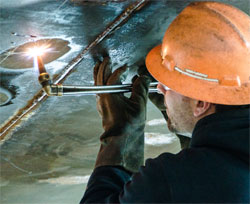In mid February, the 120-foot ASD tug Bob Franco was in dry dock at the Diversified Marine shipyard in Portland, Ore. When completed in late spring or early summer, the tug will join the fleet of a Harley Marine Services subsidiary, Olympic Tug & Barge, and work in Cook Inlet, Alaska.
The tug — named for the father of Harley Marine’s owner, Harley Franco — was designed by Jensen Maritime Consultants, a subsidiary of Crowley Maritime Corp. with offices in Seattle. The design of Bob Franco is based on a series of three tugboats that Jensen developed for Western Towboat, a company based in Seattle, but primarily working in the Alaska trade.
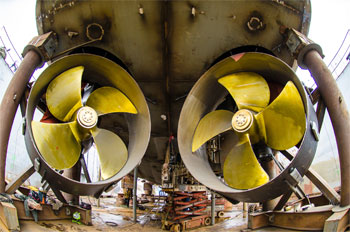 |
|
The stern drives should produce a bollard pull of about 70 tons. |
It has been a busy year for Seattle-based Harley Marine. The company has taken delivery of the ocean towing tug Kestrel, built at Halimar Shipyard in Morgan City, La., on the Gulf Coast. Two ASD tugs, Robert Franco and Ahbra Franco, are under construction at Nichols Brothers Boat Builders in Freeland, Wash.
It has also been a busy year for Diversified Marine, whose yard is on the Columbia River. At the time of my visit, Bob Franco was surrounded by a full book of repair and new construction work and Diversified’s fleet of tugs and workboats. The workboats are primarily employed on construction projects along the Columbia and Willamette rivers. If it had been a sunny day, the revolving shadow of the 160-foot boom crane, Freedom, would have cast its shadow over a flotilla as diversified as the yard’s name implies.
 |
“We’ve doubled our employees,” said the yard owner, Kurt Redd. “Last year we had 25 and there are 55 working now.” Pointing to the extensive increase in the number of stiffeners and the ice strengthened hull plating on the bow of Bob Franco, Redd said, “They’ve spent some money to build this boat to suit the service for their customer and the state of Alaska.”
A walk through the unfinished galley and crew quarters of Bob Franco gave the impression of being inside a spacious cavity lined with a generous three-inches plus of fiber insulation draped in silver foil and gleaming like a space blanket. Everything was wrapped, including the piping, leaving little doubt where this tug was intended to work.
“It’s had over $2 million worth of upgrades just to deal with the ice and cold,” said Gregg Nelson, vice president of engineering for Harley Marine. “The insulation in the living spaces has been increased substantially to accommodate for the cold weather that it’s going to be working in.” Nelson went on to list where some of that money went to combat Alaska’s severe winters: heated ballast tanks, heated potable water tanks, heated pilothouse windows, heated decks.
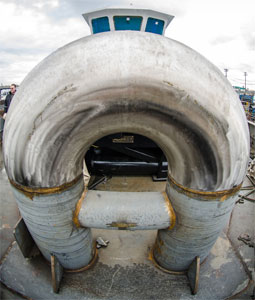 |
|
The massive stainless steel staple forward of the electric bow winch, which is also from Markey. |
“The grid coolers have been reinforced with substantial protection against the ice,” said Nelson. The generators are 300-kW Caterpillar C9s, bigger than usual to accommodate the heavy heating loads. “In the bow we added extensive ribbing and half-inch plate.”
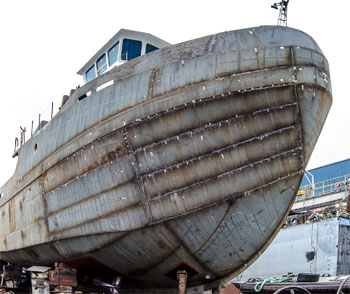 |
|
The hull has been strengthened for Arctic service.
|
The tug itself is a 120-by-35-by-19.25-foot heavyweight powered by two 2,500-hp Caterpillar Tier 3 C175 engines driving Schottel azimuthing stern drives. Nelson said they expect the bollard pull to be around 70 tons. On the bow there is a Markey Machinery 75-hp DEPCF-52 electric hawser winch, a winch designed for high line speeds when conducting ship assist and escort duties. The drum capacity is for 750 feet of 10-inch circumference synthetic line.
On the aft deck, there is a Markey Machinery TESD-34 double-drum 100-hp electric towing winch with a high line-pull and braking capacity, designed specifically for offshore towing or anchor-handling applications. It is equipped with a fairlead and warping head. The winch features a digital and analog line tension display system and multiple station controls. Nelson said that the drum will be wrapped with 2,600 feet of two-inch diameter wire rope. The unit weighs in at 26 tons.
“All of the winches on this boat are electric,” said Nelson, “so there is no environmental impact there.”
Schuyler Rubber of Woodinville, Wash., supplied all of the fendering for Bob Franco, including an 18-inch diameter model SSR-WB cylindrical shaped upper bow fender which, according to Greg Armfield of Schuyler, covered more than 40 feet of the bow area running aft along the shear strake. The rubber package also included a lower bow fender running vertically below to protect the hull from damage when the tug conducts low draft work. “The Schuyler stern fenders are model 114 solid type,” said Armfield. “This type of fender provides a smooth surface for shiphandling along the stern area with proven capabilities when performing in ice.”
“She is going on charter with an oil company to work Cook Inlet bringing the boats in and out of Nikiski,” said Nelson. “It will be set up for ocean towing, but its primary mission will be ship assist in Nikiski, and ice breaking. The work we’re doing on the Bob is customer oriented. We’re a very customer-service friendly company and we will go out of our way and do whatever we can to keep them happy.”
Bob Franco’s duties will also include emergency towing and oil spill response. “We’re putting equipment like a hydraulic crane and some other things on the aft deck to use in the event of a spill,” said Nelson.
As with the greening of the Arctic, marine operating companies are getting greener every year. Engaged in plying some of the most sensitive habitat on the planet, the companies working there have restrictions, regulations and commitments — both legislated and client- or self-motivated — designed to protect the land and the water from man-made pollutants. Implementing the equipment, the engineering and the training to address those concerns is not exclusive to Harley Marine, but the company has certainly been recognized for its clean and green practices, boasting four major environmental awards since 2009.
Those awards include: the 2011 Marine Environmental Business of the Year for Environmental Initiative from the Port of Seattle and Propeller Club of Seattle; first place for Environmental Initiative in the 2010 WorkBoat Environmental Awards; the 2010 EPA Environmental Quality Award (the first marine environmental award from the EPA); and third place for Comprehensive Environmental Management Plan in the 2009 WorkBoat Environmental Awards.
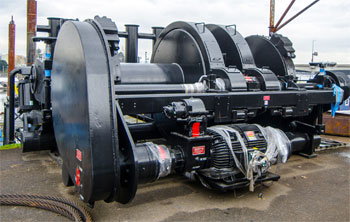 |
|
The Markey Machinery TESD-34 100-hp double-drum electric towing winch. |
To garner those awards, Harley Marine has an aggressive overhaul and replacement program in place to upgrade its tug fleet with new and cleaner burning engines, and its barge fleet with patented barge mounted vapor recovery units that exceed present day air quality requirements.
The company has also instituted an environmental management system and attained an ISO 14001 environmental certification covering the nine Harley Marine subsidiaries, including their tugs, barges, shops and offices. The company also has an ISO 9001 safety management system and is designated as a responsible carrier under the Responsible Carrier Program of the American Waterways Operators.
“The construction of a tugboat that meets Tier 3 emissions compliance is a great step forward in environmental protection for our industry,” said Jensen Vice President Johan Sperling. “It was important for us to design a powerful and capable tugboat for Harley, but also one that takes care of the environment in the process.”
“One of our company mottos is to protect the environment,” said Nelson. “The Bob actually started out with field-follow engines (C175s) because they were brand new and Cat was using us as a beta test site. We’re probably one of the most environmentally sensitive companies out there.”


